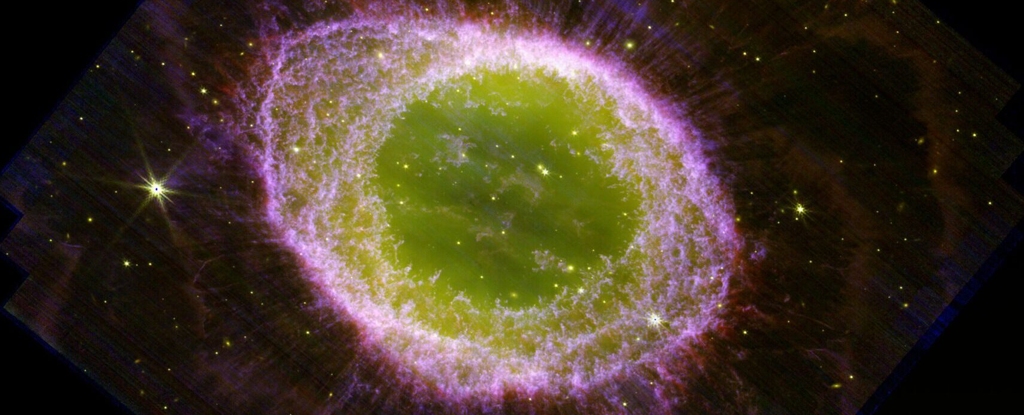
“We are witnessing the final chapters of a star’s life, a preview of the Sun’s distant future so to speak, and JWST’s observations have opened a new window into understanding these awe-inspiring cosmic events,”
The James Webb Space Telescope has captured new images of a dying star, radiating a golden hue during its final stages.
The celestial body in focus is Messier 57, also known as the Ring Nebula, a luminous gas halo situated within the Lyra constellation. This nebula, formed around 2,750 light-years away from our planet, originates from the expelling of substances by a less massive star in the throes of its demise. Leveraging the remarkable capabilities of the JWST, these images present an astonishing level of detail, exposing the intricate clusters and configurations within the ejected material. Through this enhanced visual exploration, scientists are poised to gain deeper insights into the processes that unfold as stars akin to our Sun conclude their cosmic journey.
“We are witnessing the final chapters of a star’s life, a preview of the Sun’s distant future so to speak, and JWST’s observations have opened a new window into understanding these awe-inspiring cosmic events,”
According to astrophysicist Mike Barlow from University College London in the United Kingdom, who also serves as a co-leader for the international JWST Ring Nebula Project,
A planetary nebula’s nomenclature is misleading, as it bears no relation to planets. The moniker originated from 18th-century astronomers who associated their spherical appearance with that of planets. In reality, these entities are significantly more expansive and vibrant. They consist of vast expanses of matter enveloping stars with masses below eight times that of the Sun, which are in the final stages of their existence.
Upon depletion of the fusion-sustaining materials within their cores, these stars undergo destabilization, expelling their outer substances. The central stellar core, devoid of the fusion-driven outward force, succumbs to gravity’s pull, resulting in the formation of a white dwarf. Such is the ultimate destiny awaiting the Sun and a majority of stars within the Milky Way galaxy.
The genesis of the Ring Nebula can be attributed to a star that concluded its fusion processes within the past 2,000 years, as viewed from our vantage point. Encompassing its core lies a white dwarf, measuring approximately 60 percent of the Sun’s mass. The substances encircling this celestial body are presently extending outward into the cosmos, forming a spherical structure that, from our perspective, manifests as a luminous ring brimming with radiant matter.
The outer layer of the nebula possesses substantial thickness and is laden with dust, presenting elaborate formations where it intersects and engages with the interstellar medium. Scrutinizing these formations holds the potential to offer scientists insights into the physical mechanisms driving the contours and enlargement of a planetary nebula. The JWST’s high-resolution imagery has delivered awe-inspiring intricacy to this study.
While the data is currently in the process of being analyzed, the initial observations are unmasking an unforeseen intricacy that has ignited the team’s enthusiasm for further investigation. Apart from the remarkable structural intricacies unveiled within the shell, the observations have also yielded an abundance of information concerning the nebula’s composition. This includes the presence of substantial carbon-based molecules of significant size, the origins of which remain enigmatic at this juncture.

